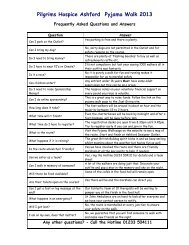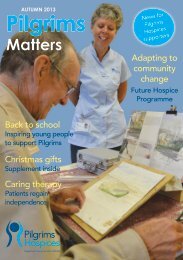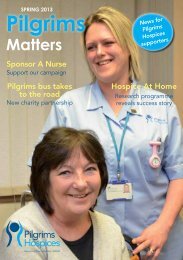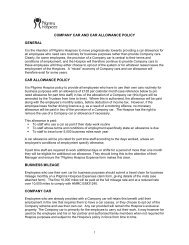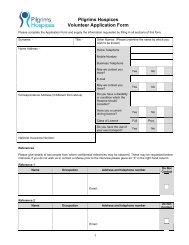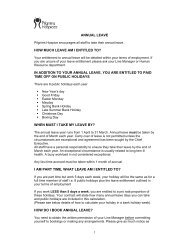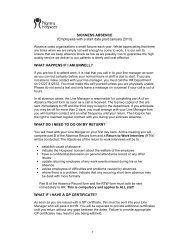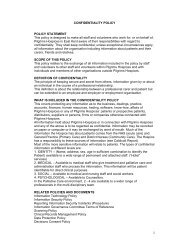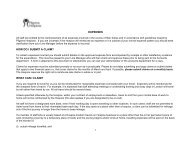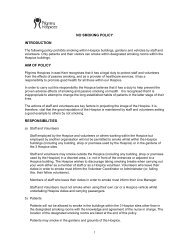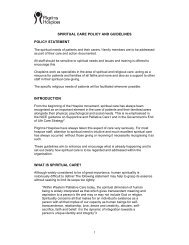Inspection Report - Pilgrims Hospices
Inspection Report - Pilgrims Hospices
Inspection Report - Pilgrims Hospices
Create successful ePaper yourself
Turn your PDF publications into a flip-book with our unique Google optimized e-Paper software.
<strong>Inspection</strong> <strong>Report</strong><br />
We are the regulator: Our job is to check whether hospitals, care homes and care<br />
services are meeting essential standards.<br />
<strong>Pilgrims</strong> Hospice Ashford<br />
Hythe Road, Willesborough, Ashford, TN24 0NE Tel: 01233504100<br />
Date of <strong>Inspection</strong>: 01 February 2013 Date of Publication: February<br />
2013<br />
We inspected the following standards as part of a routine inspection. This is what we<br />
found:<br />
Consent to care and treatment<br />
Care and welfare of people who use services<br />
Cleanliness and infection control<br />
Staffing<br />
Complaints<br />
Met this standard<br />
Met this standard<br />
Met this standard<br />
Met this standard<br />
Met this standard<br />
| <strong>Inspection</strong> <strong>Report</strong> | <strong>Pilgrims</strong> Hospice Ashford | February 2013 www.cqc.org.uk 1
Details about this location<br />
Registered Provider<br />
Registered Manager<br />
Overview of the<br />
service<br />
Type of service<br />
Regulated activities<br />
<strong>Pilgrims</strong> <strong>Hospices</strong> in East Kent<br />
Mr. Shaun Stacey<br />
The <strong>Pilgrims</strong> Hospice provides specialist palliative care,<br />
advice and clinical support for people with life limiting illness,<br />
their carers and families. There is a 16 bed in-patient unit<br />
and a day therapy hospice with various clinics and drop in<br />
centres. There is a bereavement counselling service.<br />
Services are provided by health professionals and<br />
volunteers.<br />
Hospice services<br />
Diagnostic and screening procedures<br />
Management of supply of blood and blood derived products<br />
Surgical procedures<br />
Treatment of disease, disorder or injury<br />
| <strong>Inspection</strong> <strong>Report</strong> | <strong>Pilgrims</strong> Hospice Ashford | February 2013 www.cqc.org.uk 2
Contents<br />
When you read this report, you may find it useful to read the sections towards the back<br />
called 'About CQC inspections' and 'How we define our judgements'.<br />
Summary of this inspection:<br />
Page<br />
Why we carried out this inspection 4<br />
How we carried out this inspection 4<br />
What people told us and what we found 4<br />
More information about the provider 4<br />
Our judgements for each standard inspected:<br />
Consent to care and treatment 5<br />
Care and welfare of people who use services 6<br />
Cleanliness and infection control 7<br />
Staffing 8<br />
Complaints 9<br />
About CQC <strong>Inspection</strong>s 10<br />
How we define our judgements 11<br />
Glossary of terms we use in this report 13<br />
Contact us 15<br />
| <strong>Inspection</strong> <strong>Report</strong> | <strong>Pilgrims</strong> Hospice Ashford | February 2013 www.cqc.org.uk 3
Summary of this inspection<br />
Why we carried out this inspection<br />
This was a routine inspection to check that essential standards of quality and safety<br />
referred to on the front page were being met. We sometimes describe this as a scheduled<br />
inspection.<br />
This was an unannounced inspection.<br />
How we carried out this inspection<br />
We looked at the personal care or treatment records of people who use the service,<br />
carried out a visit on 1 February 2013, observed how people were being cared for and<br />
checked how people were cared for at each stage of their treatment and care. We talked<br />
with people who use the service, talked with carers and / or family members and talked<br />
with staff.<br />
What people told us and what we found<br />
All the patients said that they had understood the treatment or reason for which they were<br />
at the hospice.<br />
Patients said that, before admission, there was a full assessment of their needs, "It was all<br />
talked through with me" commented one patient. Patients were very pleased with the<br />
quality of the care that they had received. They said staff were, "very attentive and reassuring<br />
and experienced" and "nothing is too much trouble".<br />
The hospice was clean and free from noxious smells. It was light and bright. There was a<br />
large garden with quiet areas set aside for contemplation.<br />
We found that there were sufficient trained and experienced staff.<br />
There was a complaints system that patients were aware of and which was effective.<br />
You can see our judgements on the front page of this report.<br />
More information about the provider<br />
Please see our website www.cqc.org.uk for more information, including our most recent<br />
judgements against the essential standards. You can contact us using the telephone<br />
number on the back of the report if you have additional questions.<br />
There is a glossary at the back of this report which has definitions for words and phrases<br />
we use in the report.<br />
| <strong>Inspection</strong> <strong>Report</strong> | <strong>Pilgrims</strong> Hospice Ashford | February 2013 www.cqc.org.uk 4
Our judgements for each standard inspected<br />
Consent to care and treatment<br />
Met this standard<br />
Before people are given any examination, care, treatment or support, they should<br />
be asked if they agree to it<br />
Our judgement<br />
The provider was meeting this standard.<br />
Before people received any care or treatment they were asked for their consent and the<br />
provider acted in accordance with their wishes.<br />
Reasons for our judgement<br />
Patients had asked to come to the hospice and on most occasions patients' consent to<br />
care and treatment was verbal. We saw that consent was valid because patients were<br />
involved in the care they received. For example care notes frequently contained phrases<br />
such as, 'discussed medication and pt (patient) agreed to analgesic' and, from the<br />
Chaplain, 'spent some time talking to (name) about dying and said she wanted ...'.<br />
Where patients had certain treatments such as blood transfusions and intravenous drug<br />
infusions we saw that specific signed consent had been obtained.<br />
Most patients in the in-patient unit had decided that they did not wish to be resuscitated in<br />
the event of heart failure. These decisions were called "do not attempt resuscitation"<br />
(DNAR) decisions. We saw that patients had been appropriately consulted over these<br />
decisions. This was reflected in some of the care notes, for example one DNAR entry<br />
said, '... did not want (name) informed about the decision'.<br />
The head of nursing told us that to date all the patients had had the capacity to and had<br />
made their own decisions. When we talked to staff they were aware of the need to<br />
consider Deprivation of Liberty Safeguards (DoLS) should a patient lack capacity. We<br />
were told that the hospice had considered making such an application in the case of a<br />
person with cancer and a secondary injury. However the staff had been able to make use<br />
of a disability distress assessment tool to improve communication and this made the DoLS<br />
application unnecessary.<br />
| <strong>Inspection</strong> <strong>Report</strong> | <strong>Pilgrims</strong> Hospice Ashford | February 2013 www.cqc.org.uk 5
Care and welfare of people who use services<br />
Met this standard<br />
People should get safe and appropriate care that meets their needs and supports<br />
their rights<br />
Our judgement<br />
The provider was meeting this standard.<br />
People's needs were assessed and care and treatment was planned and delivered in line<br />
with their individual care plan.<br />
Reasons for our judgement<br />
There was an assessment of the patient before admission either to the in-patient unit or<br />
other service. We saw assessment included, but was not confined to; falls, wounds,<br />
nausea, medical conditions (such as diabetes) and current medication. Decisions were<br />
based on what was best for the patient. For example patients were not routinely weighed<br />
on admission. If the staff thought that the patient might be shocked by their recent weigh<br />
loss then weighing them was deferred, until they had settled in, or not carried out.<br />
Patients were very impressed by the quality of the care they received. Comments we<br />
heard included, "all have a nice word and call you by your Christian name if that is what<br />
you want", "the way they behave ... nothing is too much trouble" and "wonderful,<br />
wonderful, wonderful".<br />
Patients were involved in their care. Their comments evidenced this, for example, "... and<br />
it was all discussed with me ... stabilise me and control the pain which they have achieved"<br />
and "I am not worried, I know what will happen, we have talked it all through". We looked<br />
at records in the in-patient unit. They showed that patients were involved in their care.<br />
Entries included, '(name) said she has washed today and does not want another' and 'pain<br />
discussed and (drug and dosage) agreed'. Patients' allergies and adverse reaction to<br />
drugs were noted on the care records, for example we saw, 'hallucinates with zomorph' (a<br />
pain killer) noted on one file.<br />
There was a meeting at the in-patient unit each morning. The needs of in-patients,<br />
prospective in-patients and community patients were discussed. The meeting was<br />
attended by medical staff, social services, occupational therapists, counsellors and the<br />
chaplaincy as required. This allowed the staff to plan admissions and keep families<br />
informed.<br />
Close attention was paid to pressure sores. We saw there were routines for turning<br />
patients to avoid sores. Sores were regularly dressed and changes carefully noted.<br />
There was a mouth/oral assessment every third day. A sore mouth is a common symptom<br />
in cancer patients that can reduce their quality of life.<br />
| <strong>Inspection</strong> <strong>Report</strong> | <strong>Pilgrims</strong> Hospice Ashford | February 2013 www.cqc.org.uk 6
Cleanliness and infection control<br />
Met this standard<br />
People should be cared for in a clean environment and protected from the risk of<br />
infection<br />
Our judgement<br />
The provider was meeting this standard.<br />
People were protected from the risk of infection because appropriate guidance had been<br />
followed.<br />
Reasons for our judgement<br />
We inspected the hospice building. It was clean and tidy and free from noxious smells.<br />
The rooms were clean and there was no dust on the surfaces. One patient commented,<br />
"faultless cleaning".<br />
The head of nursing was responsible for Infection Prevention Control (IPC).<br />
At ward level there was a link nurse appointed help ensure day to day compliance with IPC<br />
standards. The nurse linked with East Kent Hospitals University NHS Foundation Trust<br />
whose policies and procedures the hospice followed. We saw that the nurse had received<br />
specialist training, attended specialist study days and met with IPC staff in the community.<br />
The nurse had recently carried out an IPC audit but the results were not yet available. The<br />
audit had included general cleanliness, mattresses and disposals of 'sharps' (that is<br />
needles and such like).<br />
Where patients were cared for who had infections such as Clostridium difficile they were<br />
nursed in single rooms with signs placed on the door to inform staff of the infection. The<br />
more vulnerable patients were in rooms closest to the nursing station.<br />
We spoke with the cleaning staff. Patients' rooms were cleaned daily. This meant wiping<br />
down all surfaces with a medical sanitising fluid, cleaning the bathrooms and toilets.<br />
Rooms were deep cleaned when the nursing staff requested it for example after an<br />
infectious patient had been nursed in the rooms. Deep cleaning entailed the use of steam<br />
cleaners and a diluted chlorine solution.<br />
The records of which rooms had been deep cleaned and when were carefully recorded<br />
and detailed. However the provider might like to note that there was no schedule to<br />
ensure that all the rooms were deep cleaned regularly.<br />
There were alcohol based hand washes at frequent intervals around the hospice though<br />
staff we spoke with knew that hand washing with soap and water was considered the more<br />
effective preventative measure.<br />
| <strong>Inspection</strong> <strong>Report</strong> | <strong>Pilgrims</strong> Hospice Ashford | February 2013 www.cqc.org.uk 7
Staffing<br />
Met this standard<br />
There should be enough members of staff to keep people safe and meet their<br />
health and welfare needs<br />
Our judgement<br />
The provider was meeting this standard.<br />
There were enough qualified, skilled and experienced staff to meet people's needs.<br />
Reasons for our judgement<br />
Patients we spoke with said that if they pressed their bell for attention they were seen fairly<br />
quickly. "If you ask it's there, if they have not got it they will get it for you" and "yes, very<br />
attentive" were comments made to us. We saw during the inspection that staff answered<br />
call bells within a reasonable time.<br />
The minimum staffing in the in-patient unit was as follows: day shift three nurses and four<br />
healthcare assistants (HCA), late shift three nurses and two HCAs, nights two nurses and<br />
one HCA. In addition there were two 'buddy' staff who were not healthcare trained. There<br />
were also other supervisory medical staff on duty within the hospice. Staff we spoke with<br />
felt that the staffing levels were adequate.<br />
The hospice had recently taken part in a study into staffing levels in in-patient palliative<br />
care. The surveys, in 2010 and 2012, showed that the dependency of patients was<br />
increasing. It also showed that the <strong>Pilgrims</strong> Hospice had lower levels of direct nursing to<br />
patient contact time than other hospices (who took part in the survey). As a consequence<br />
the hospice management have committed extra money to fund an additional staff nurse on<br />
the day and late shifts. There will also be an additional sister at the site.<br />
| <strong>Inspection</strong> <strong>Report</strong> | <strong>Pilgrims</strong> Hospice Ashford | February 2013 www.cqc.org.uk 8
Complaints<br />
Met this standard<br />
People should have their complaints listened to and acted on properly<br />
Our judgement<br />
The provider was meeting this standard.<br />
There was an effective complaints system available. Comments and complaints people<br />
made were responded to appropriately.<br />
Reasons for our judgement<br />
Patients we spoke with did not have any complaints. They said that they felt sure that if<br />
they did have a complaint they would be taken seriously.<br />
Clear complaints procedures were in place. There were time lines when the complainant<br />
could expect to have received a reply about their complaint and from whom. The provider<br />
might like to note that although patients were told informally of the comments and<br />
complaints process there no formal document to which they, or their families, could refer<br />
during their stay.<br />
There was a complaints log. The contents were discussed at the quarterly governance<br />
meetings. We saw that complaints and adverse verbal comments were taken seriously.<br />
As one manager put it,"It is not for us to say (if an adverse comment was a complaint) if it<br />
is important to the patient or relative it is worthy of attention".<br />
There was a robust investigation of complaints. We saw from the complaints log that<br />
many of the complaints were upheld. Lessons were learned from complaints. The<br />
majority were about communication either between the staff and the patient or the staff<br />
and other health or social care bodies. Sometimes communication skills were discussed<br />
with individuals. Where the learning was wider we saw that it was taken to the appropriate<br />
level. For example one complaints' log entry stated, 'Put on the agenda to share learning<br />
at an education forum as "difficult conversations".'<br />
| <strong>Inspection</strong> <strong>Report</strong> | <strong>Pilgrims</strong> Hospice Ashford | February 2013 www.cqc.org.uk 9
About CQC inspections<br />
We are the regulator of health and social care in England.<br />
All providers of regulated health and social care services have a legal responsibility to<br />
make sure they are meeting essential standards of quality and safety. These are the<br />
standards everyone should be able to expect when they receive care.<br />
The essential standards are described in the Health and Social Care Act 2008 (Regulated<br />
Activities) Regulations 2010 and the Care Quality Commission (Registration) Regulations<br />
2009. We regulate against these standards, which we sometimes describe as "government<br />
standards".<br />
We carry out unannounced inspections of all care homes, acute hospitals and domiciliary<br />
care services in England at least once a year to judge whether or not the essential<br />
standards are being met. We carry out inspections of dentists and other services at least<br />
once every two years. All of our inspections are unannounced unless there is a good<br />
reason to let the provider know we are coming.<br />
There are 16 essential standards that relate most directly to the quality and safety of care<br />
and these are grouped into five key areas. When we inspect we could check all or part of<br />
any of the 16 standards at any time depending on the individual circumstances of the<br />
service. Because of this we often check different standards at different times but we<br />
always inspect at least one standard from each of the five key areas every year. We may<br />
check fewer key areas in the case of dentists and some other services.<br />
When we inspect, we always visit and we do things like observe how people are cared for,<br />
and we talk to people who use the service, to their carers and to staff. We also review<br />
information we have gathered about the provider, check the service's records and check<br />
whether the right systems and processes are in place.<br />
We focus on whether or not the provider is meeting the standards and we are guided by<br />
whether people are experiencing the outcomes they should be able to expect when the<br />
standards are being met. By outcomes we mean the impact care has on the health, safety<br />
and welfare of people who use the service, and the experience they have whilst receiving<br />
it.<br />
Our inspectors judge if any action is required by the provider of the service to improve the<br />
standard of care being provided. Where providers are non-compliant with the regulations,<br />
we take enforcement action against them. If we require a service to take action, or if we<br />
take enforcement action, we re-inspect it before its next routine inspection was due. This<br />
could mean we re-inspect a service several times in one year. We also might decide to reinspect<br />
a service if new concerns emerge about it before the next routine inspection.<br />
In between inspections we continually monitor information we have about providers. The<br />
information comes from the public, the provider, other organisations, and from care<br />
workers.<br />
You can tell us about your experience of this provider on our website.<br />
| <strong>Inspection</strong> <strong>Report</strong> | <strong>Pilgrims</strong> Hospice Ashford | February 2013 www.cqc.org.uk 10
How we define our judgements<br />
The following pages show our findings and regulatory judgement for each essential<br />
standard or part of the standard that we inspected. Our judgements are based on the<br />
ongoing review and analysis of the information gathered by CQC about this provider and<br />
the evidence collected during this inspection.<br />
We reach one of the following judgements for each essential standard inspected.<br />
Met this standard<br />
This means that the standard was being met in that the<br />
provider was compliant with the regulation. If we find that<br />
standards were met, we take no regulatory action but we<br />
may make comments that may be useful to the provider and<br />
to the public about minor improvements that could be made.<br />
Action needed<br />
This means that the standard was not being met in that the<br />
provider was non-compliant with the regulation.<br />
We may have set a compliance action requiring the provider<br />
to produce a report setting out how and by when changes<br />
will be made to make sure they comply with the standard.<br />
We monitor the implementation of action plans in these<br />
reports and, if necessary, take further action.<br />
We may have identified a breach of a regulation which is<br />
more serious, and we will make sure action is taken. We will<br />
report on this when it is complete.<br />
Enforcement<br />
action taken<br />
If the breach of the regulation was more serious, or there<br />
have been several or continual breaches, we have a range of<br />
actions we take using the criminal and/or civil procedures in<br />
the Health and Social Care Act 2008 and relevant<br />
regulations. These enforcement powers include issuing a<br />
warning notice; restricting or suspending the services a<br />
provider can offer, or the number of people it can care for;<br />
issuing fines and formal cautions; in extreme cases,<br />
cancelling a provider or managers registration or prosecuting<br />
a manager or provider. These enforcement powers are set<br />
out in law and mean that we can take swift, targeted action<br />
where services are failing people.<br />
| <strong>Inspection</strong> <strong>Report</strong> | <strong>Pilgrims</strong> Hospice Ashford | February 2013 www.cqc.org.uk 11
How we define our judgements (continued)<br />
Where we find non-compliance with a regulation (or part of a regulation), we state which<br />
part of the regulation has been breached. We make a judgement about the level of impact<br />
on people who use the service (and others, if appropriate to the regulation) from the<br />
breach. This could be a minor, moderate or major impact.<br />
Minor impact – people who use the service experienced poor care that had an impact on<br />
their health, safety or welfare or there was a risk of this happening. The impact was not<br />
significant and the matter could be managed or resolved quickly.<br />
Moderate impact – people who use the service experienced poor care that had a<br />
significant effect on their health, safety or welfare or there was a risk of this happening.<br />
The matter may need to be resolved quickly.<br />
Major impact – people who use the service experienced poor care that had a serious<br />
current or long term impact on their health, safety and welfare, or there was a risk of this<br />
happening. The matter needs to be resolved quickly<br />
We decide the most appropriate action to take to ensure that the necessary changes are<br />
made. We always follow up to check whether action has been taken to meet the<br />
standards.<br />
| <strong>Inspection</strong> <strong>Report</strong> | <strong>Pilgrims</strong> Hospice Ashford | February 2013 www.cqc.org.uk 12
Glossary of terms we use in this report<br />
Essential standard<br />
The essential standards of quality and safety are described in our Guidance about<br />
compliance: Essential standards of quality and safety. They consist of a significant number<br />
of the Health and Social Care Act 2008 (Regulated Activities) Regulations 2010 and the<br />
Care Quality Commission (Registration) Regulations 2009. These regulations describe the<br />
essential standards of quality and safety that people who use health and adult social care<br />
services have a right to expect. A full list of the standards can be found within the<br />
Guidance about compliance. The 16 essential standards are:<br />
Respecting and involving people who use services - Outcome 1 (Regulation 17)<br />
Consent to care and treatment - Outcome 2 (Regulation 18)<br />
Care and welfare of people who use services - Outcome 4 (Regulation 9)<br />
Meeting Nutritional Needs - Outcome 5 (Regulation 14)<br />
Cooperating with other providers - Outcome 6 (Regulation 24)<br />
Safeguarding people who use services from abuse - Outcome 7 (Regulation 11)<br />
Cleanliness and infection control - Outcome 8 (Regulation 12)<br />
Management of medicines - Outcome 9 (Regulation 13)<br />
Safety and suitability of premises - Outcome 10 (Regulation 15)<br />
Safety, availability and suitability of equipment - Outcome 11 (Regulation 16)<br />
Requirements relating to workers - Outcome 12 (Regulation 21)<br />
Staffing - Outcome 13 (Regulation 22)<br />
Supporting Staff - Outcome 14 (Regulation 23)<br />
Assessing and monitoring the quality of service provision - Outcome 16 (Regulation 10)<br />
Complaints - Outcome 17 (Regulation 19)<br />
Records - Outcome 21 (Regulation 20)<br />
Regulated activity<br />
These are prescribed activities related to care and treatment that require registration with<br />
CQC. These are set out in legislation, and reflect the services provided.<br />
| <strong>Inspection</strong> <strong>Report</strong> | <strong>Pilgrims</strong> Hospice Ashford | February 2013 www.cqc.org.uk 13
Glossary of terms we use in this report (continued)<br />
(Registered) Provider<br />
There are several legal terms relating to the providers of services. These include<br />
registered person, service provider and registered manager. The term 'provider' means<br />
anyone with a legal responsibility for ensuring that the requirements of the law are carried<br />
out. On our website we often refer to providers as a 'service'.<br />
Regulations<br />
We regulate against the Health and Social Care Act 2008 (Regulated Activities)<br />
Regulations 2010 and the Care Quality Commission (Registration) Regulations 2009.<br />
Responsive inspection<br />
This is carried out at any time in relation to identified concerns.<br />
Routine inspection<br />
This is planned and could occur at any time. We sometimes describe this as a scheduled<br />
inspection.<br />
Themed inspection<br />
This is targeted to look at specific standards, sectors or types of care.<br />
| <strong>Inspection</strong> <strong>Report</strong> | <strong>Pilgrims</strong> Hospice Ashford | February 2013 www.cqc.org.uk 14
Contact us<br />
Phone: 03000 616161<br />
Email:<br />
enquiries@cqc.org.uk<br />
Write to us<br />
at:<br />
Care Quality Commission<br />
Citygate<br />
Gallowgate<br />
Newcastle upon Tyne<br />
NE1 4PA<br />
Website:<br />
www.cqc.org.uk<br />
Copyright Copyright © (2011) Care Quality Commission (CQC). This publication may<br />
be reproduced in whole or in part, free of charge, in any format or medium provided<br />
that it is not used for commercial gain. This consent is subject to the material being<br />
reproduced accurately and on proviso that it is not used in a derogatory manner or<br />
misleading context. The material should be acknowledged as CQC copyright, with the<br />
title and date of publication of the document specified.<br />
| <strong>Inspection</strong> <strong>Report</strong> | <strong>Pilgrims</strong> Hospice Ashford | February 2013 www.cqc.org.uk 15



